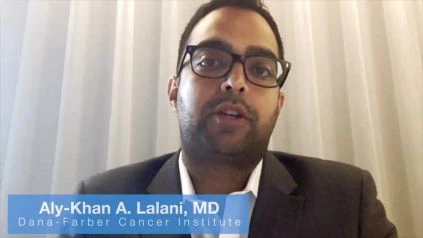Dr. Aly-Khan Lalani, MD highlights a study he presented at ESMO 2017 about the usefulness Neutrophil-to-lymphocyte ratio (NLR) and how they might be a good prognosticator in mRCC. Below is an overview of the study and it’s findings.
RESULTS:
Table 2. Association of NLR at baseline, at 6-weeks, and change at week 6 (±2) with treatment outcomes in multivariable Cox and Logistic regression models
BACKGROUND:
Inflammation is a hallmark of solid tumors, where neutrophilia occurs as an inflammatory response and may suppress the cytolytic activity of immune cells such as lymphocytes, natural killer cells, and activated T cells1
Elevated NLR is associated with worse outcomes in several malignancies, including metastatic renal cell carcinoma (mRCC) patients treated with oral tyrosine kinase inhibitors (VEGF-TKIs)2
However, the utility of NLR in mRCC patients treated with conventional immune checkpoint blockade is not well characterized
OBJECTIVES:
To evaluate the association of baseline NLR, and changes during treatment, with outcomes in mRCC patients treated with immune checkpoint blockade
METHODS:
Retrospective cohort study of mRCC patients treated with PD-1/PD-L1 immune checkpoint blockade (ICB) at Dana-Farber Cancer Institute from 2009-2017 with NLR measured at baseline and 6 (±2) weeks on therapy
We first investigated the impact of baseline NLR (natural log-transformed [LnNLR]) on objective response rate (ORR, complete response or partial response), progression free survival (PFS, time from start of ICB to radiographic or clinical progression, or death), and overall survival (OS, time from start of ICB to death/last follow up)
Landmark analysis at 6 weeks was also conducted to explore the prognostic value of LnNLR at 6 (±2) weeks or relative NLR change (calculated as % change ({[NLR week 6 / NLR week 0] – 1}*100) and subsequently grouped in three groups (?25% decrease, no change, ?25% increase) on ORR, PFS, and OS
Cox or logistic regression models allowed for adjustment of line of therapy, number of IMDC risk factors, RCC histology (clear cell vs. non-clear cell), and baseline NLR
CONCLUSIONS:
? In our cohort of mRCC patients treated with PD-1/PD-L1 based immune checkpoint blockade, higher 6-week NLR was independently associated with a lower ORR, shorter PFS, and shorter OS ? Early decline of NLR (decrease ? 25% from baseline to 6-weeks after anti-PD-1/PD-L1 therapy) was associated with an improved PFS and significantly better OS, whereas an NLR increase by
? 25% was associated with poorer PFS and OS, regardless of baseline NLR levels
? The NLR appears to be a readily-available, affordable, prognostic marker in mRCC patients treated with conventional immune checkpoint blockade, and warrants larger, prospective validation

